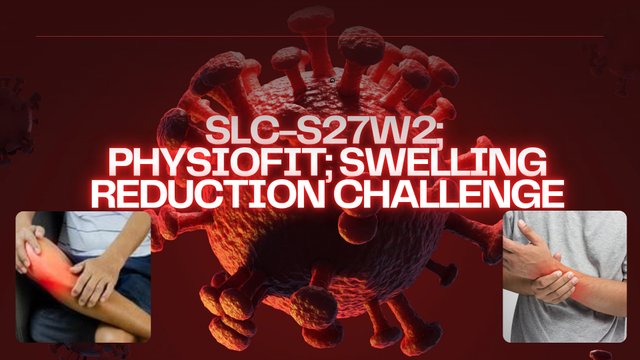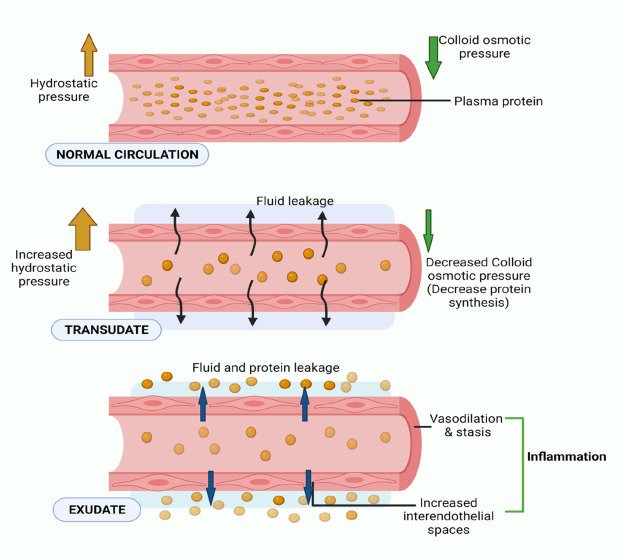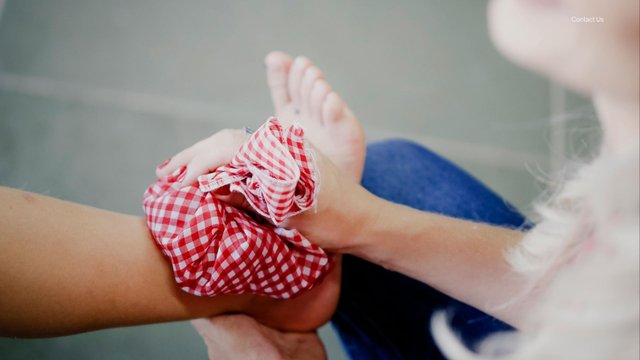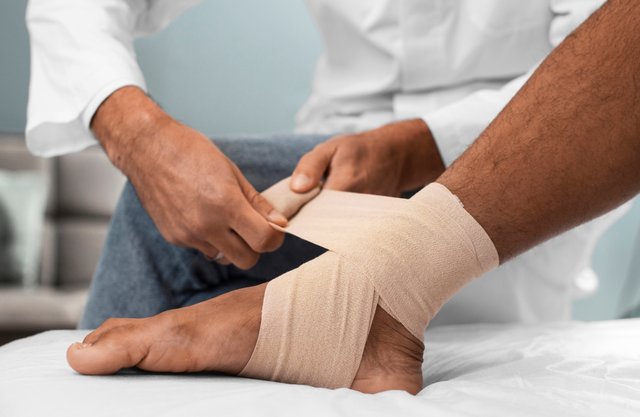Steemit Learning Challenge-S27W2; Physiofit; Swelling Reduction Challenge
Hello, everyone; we are here to share the Challenge for week 2, the 2nd week of the Steemit Learning Challenge season 27. I am grateful to all the users who participated in the previous season and supported my previous course, and thankful to the Steemit team for this opportunity again. I invite all users to share their unique participation and strive to earn good grades to be selected as the winner of the Steemit Learning Challenge, Season 27, Week 2.
Swelling
Swelling is a condition in which excess fluid accumulates in any part of the body; the second name commonly used for swelling is oedema. Swelling can occur due to sprain, strain, inflammation, infection, in response to an allergy and as a result of any medical condition like rheumatoid arthritis, etc.
Sign & Symptoms
Although we can use swelling as a symptom and sign, some symptoms of swelling help us to confirm whether it's swelling or inflammation. The first symptom that shows us its swelling is redness of the affected area, other symptoms are a feeling of warmth when we touch, the area becomes enlarged or puffy, tenderness (feeling pain when we touch that part), and limited range of motion.
Types of Swelling
There are several types of swelling like
- Localised Swelling
- Generalised Swelling
- Acute Swelling
- Chronic Swelling
- Pitting Swelling
- Non-pitting Swelling
- Inflammatory Swelling
- Non-inflammatory Swelling
Here, I will explain the 2 types, which are localised and generalised swelling.
- Localised swelling is the type that occurs in a specific area of the body, like ankle swelling, wrist, elbow, or knee swelling, as a result of sprain or strain.
- Generalised swelling is the type that is present throughout the body, like in the case of kidney failure or heart failure, as fluid accumulation increases in the whole body, especially in weight-bearing joints.
Pathophysiology
In the pathophysiology of swelling or oedema, the first is the shifting of fluid from blood vessels into the interstitial space that occurs because of increasing pressure within blood vessels or a decrease in pressure due to proteins in the blood. Because of that, vascular permeability increases, allowing more fluid to leak into the interstitial space.
Another reason for oedema or fluid accumulation is due to lymphatic system dysfunction, which plays an important role in removing the excess fluid from blood vessels and the interstitial space. Oedema or swelling can also occur due to the failure of any organ in the body, especially kidney failure and heart conditions.
Physical Therapy Intervention for Pain
The most common and effective treatment protocol used in physiotherapy for swelling or inflammation is the RICE protocol. In which we have to follow 4 steps to cure the injury and prevent any complications. They are rest, ice, compression and elevation. RICE protocol is used for injuries such as strains, sprains, any kind of swelling and inflammation.
Rest
In this, we ask the patient to rest as much as possible and to avoid weight bearing if the affected joint or part is in the lower body. And avoid stress or use if any part of the upper part of the body is affected. Because swelling can subside within days if we rest the affected part and avoid activities that can worsen the condition.
The patient should rest for at least 3 to 4 days after injury, as the wound will start healing, and sometimes weight bearing after 3 to 4 days improves wound healing or improves circulation in the affected part.
Ice
Icing is the most commonly used method to reduce pain, inflammation and swelling in the affected region. It causes the vasoconstriction of the vessels and reduces blood loss if there is an open wound, but also prevents further damage if there is a closed wound.
You have to apply a cold or ice pack for 10 to 15 minutes on the affected part and 2 to 3 times a day for at least one week, then reduce the repetitions to once a day. Avoid direct use of ice on skin and use by wrapping in a towel or cloth. Icing should be applied after a few minutes of injury and applied for 2 to 3 days after the injury.
Compression
Compression stockings, crepe or compression bandages are used to compress or firmly wrap the affected part to reduce swelling. But patients should avoid a tighter bandage as it will stop the blood circulation in the affected part.
Compression bandages or crepe bandages should be used in the first 2 to 4 days to hasten the healing and improve blood circulation.
Elevation
Elevation plays an important role in the regulation of blood circulation in the affected and other parts of the body. Elevation should be done by keeping the affected part above the level of the heart, and it will reduce swelling or inflammation in the affected part.
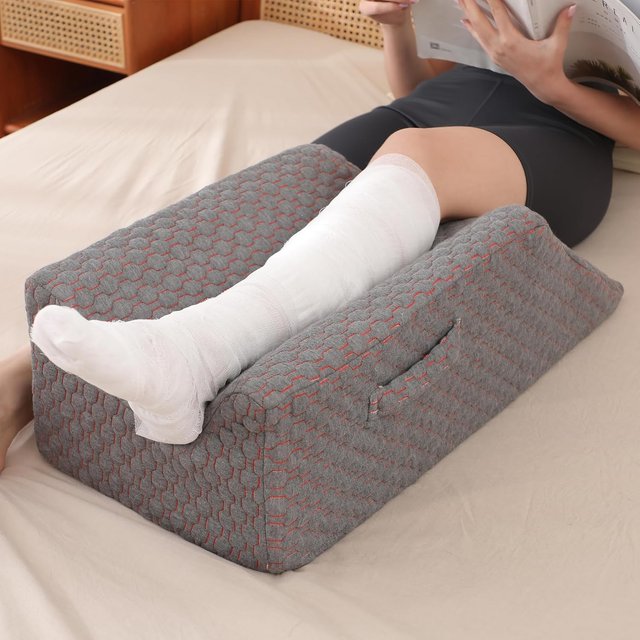
Source
We keep the affected part elevated by placing a pillow or cushion under the affected part and maintain the level above the heart level to reduce swelling, improve blood circulation and promote healing. Try to keep the affected part elevated for a few hours or try to keep it elevated at night to avoid patient irritation. Keep elevation until swelling subsides on the affected part.
- Task 1: First you have to share your knowledge about swelling, it's type and pathophysiology. (Explain only 4 types no need for extensive knowledge)
- Task 2: You have to find a patient with the symptom and share history of injury or illness. You can also share your history too if your suffer from any injury recently that is present with symptom of swelling.
- Task 3: It would be better if you treat the patient pain by performing or apply above given physiotherapy management, share videos or pictures while performing and then review after getting treatment.
You are free to post in any community.
All country members are allowed. You can write your post in any language.
- Plagiarism will not be supported. Content should be free of AI. (Content must be steemexclusive).The Title of the Post should be Steemit Learning Challenge-S27W2; Physiofit; Swelling Reduction Challenge"
The tags are, #physiofit-s27w2 (the main tag must use in your post), # #physiofit, others tags are like your country as Pakistan, club status as club100, and #steemexclusive.
Try to use your pictures, videos or gif to represent homework tasks.
Mention my username @ashkhan in your participation post.
Invite your 3 friends to participate in our contest. Upvote and Redeem the contest post so that more users participate in this and upvote.
Share your participation link under the comment section of this post.
Share your post on Twitter by adding a little information about your post and a specific hashtag like fashion, and share link on your post comment section.
Contest will start at 00:00 (UTC) Monday 6th October 2025, and end at 23:59 (UTC) Sunday 12th October 2025
Reward
All 6 winners post will be rewarded by Sc01/Sc02.
Each week we would like all Teams to make a post announcing the 6 people who have produced the best responses to the week’s Challenge tasks.
Cc,
@pennsif
@disconnect
